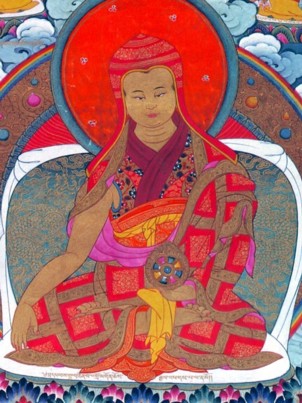Chögyal Pakpa: Difference between revisions
Jump to navigation
Jump to search
(New page: '''Chögyal Pakpa''' (1235-1280) - The hierarch of the Sakya school who was recognized as the ruler of Tibet by Kublai Khan. Category:Historical Masters Category:Sakya Masters) |
mNo edit summary |
||
| (8 intermediate revisions by 4 users not shown) | |||
| Line 1: | Line 1: | ||
'''Chögyal Pakpa''' (1235-1280) | [[Image:Chogyal Phakpa.jpg|frame|Chögyal Pakpa]] | ||
'''Chögyal Pakpa''' (Tib. ཆོས་རྒྱལ་འཕགས་པ་, [[Wyl.]] ''chos rgyal 'phags pa'') (1235-1280) — the [[Throneholders of the Sakya school|hierarch]] of the [[Sakya]] school who was recognized in 1253 as the ruler of Tibet by Kublai Khan (1215-1294) during the Yuan dynasty. He was also the nephew of [[Sakya Pandita]]. | |||
At the request of Kublai Khan, Chögyal Pakpa designed a new alphabet, the 'phags-pa script, which could be used as a unified script for the written languages within the Yuan Empire. Chögyal Pakpa extended the Tibetan alphabet, to encompass Mongol and Chinese. The actual use of this script was limited to about a hundred years during the Mongol Yuan dynasty, and it fell out of use with the advent of the Ming dynasty. | |||
==Internal Links== | |||
*[[Five Sakya patriarchs]] | |||
*[[Dzongsar Monastery]] | |||
*[[Throneholders of the Sakya school]] | |||
*[[Thirty-Seven Point Mandala Offering]] | |||
==External Links== | |||
*{{TBRC|P1048|TBRC profile}} | |||
*[http://treasuryoflives.org/biographies/view/Pakpa-Lodro-Gyeltsen/2051 Biography at Treasury of Lives] | |||
[[Category:Historical Masters]] | [[Category:Historical Masters]] | ||
[[Category:Sakya Masters]] | [[Category:Sakya Masters]] | ||
Latest revision as of 14:21, 21 August 2019

Chögyal Pakpa (Tib. ཆོས་རྒྱལ་འཕགས་པ་, Wyl. chos rgyal 'phags pa) (1235-1280) — the hierarch of the Sakya school who was recognized in 1253 as the ruler of Tibet by Kublai Khan (1215-1294) during the Yuan dynasty. He was also the nephew of Sakya Pandita.
At the request of Kublai Khan, Chögyal Pakpa designed a new alphabet, the 'phags-pa script, which could be used as a unified script for the written languages within the Yuan Empire. Chögyal Pakpa extended the Tibetan alphabet, to encompass Mongol and Chinese. The actual use of this script was limited to about a hundred years during the Mongol Yuan dynasty, and it fell out of use with the advent of the Ming dynasty.
Internal Links
- Five Sakya patriarchs
- Dzongsar Monastery
- Throneholders of the Sakya school
- Thirty-Seven Point Mandala Offering